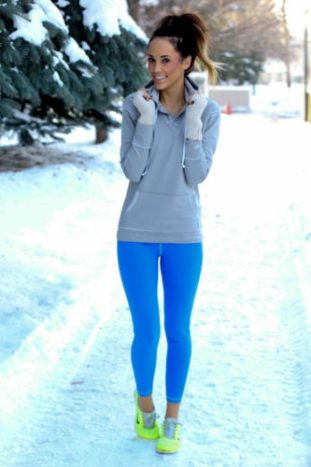While the summer evokes images of running through the park, doing dips and pulls ups on a sunny playground, or beautiful bodies on the beach, winter does not. No, winter evokes heavy baggy clothing that doesn’t care if you carry extra weight and a desire to stay inside on the couch or run through the malls shopping and eating food court calorie bombs. Well I guess for 2016 this could be perceived as sitting at your computer on Amazon and eating calorie bombs. Hey at least the mall required you to walk! These tips are designed to help you shed your perception of staying active through the cold season and boost your winter fitness!

Let’s forget the latter and look at some winter fitness ideas that will get you through the cold.
It is not too cold to exercise. While this may serve as a convenient excuse, it is not a reality in most any weather, maybe except the North Pole in which Satna has a justification.
According to Dr. John W. Castellani, exercise psychologist for the Army Research Institute of Environmental Medicine, more people are injured training in the heat than the cold. Dr. Castellani stated in a 2006 study that “you should feel cool before you start exercising. You should not feel comfortable.” The key to dressing for winter fitness is not overclothing yourself and sweating too much.
An interesting fact that U.S. Army researchers found is that male marathon winners in cold weather were only 1.7% slower than the course record in temperatures between 1-10 c (33.8-50 f).
Finally, researchers from Northern Arizona found that regular cold weather workouts actually increased running speed of test subjects by 29%. Before you say “but Arizona is hot.” Average winter highs in Northern Arizona reach low to mid 40s with lows dropping below 20.

What do I wear to train in the cold? If you are going to a commercial gym (or working at home) then your attire can stay the same, maybe avoiding sleeveless tops. If you want to go outdoors for your winter fitness routine, or even be winterfied walking the parking lot to the gym then try these options.
Start with a base layer. Opt for a more form fitting but breathable shirt like a compression shirt. Moisture wicking fabrics are best, avoid cotton and other highly absorbent fabric.
Top this with an outer sweater made of an insulated material like wool fleece. This will also help to wick moisture and promote airflow. This is the science behind shearling products like Ugg boots which actually regulate body temperature as opposed to just being a protective layer.
*Random fact: Alpaca fleece is actually warmer than wool, hypoallergic, and waterproof.
Depending on temperatures it may be necessary to add a jacket. A fabric like nylon is optimal as it will resist water and wind but still breathe. The key to dressing for winter fitness is staying dry and not restricting airflow.
Compression clothing wicks moisture from the body thus keeping you warmer. Remember sweat is meant to cool the body. Nike’s Pro Combat Hyperwarm apparel line boasts the ability to keep the body temperature regulated in any conditions.
Garments like this are great to wear as base layers. They are even great around the house. Wearing compression garments will help you stay warm and keep the furnace set lower.
An interesting fact, compression clothing has in recent years evolved beyond the gym. Many first responders, military, and construction workers who are in the field battling the elements have started wearing these garments to stay warm.
An unwanted winter coat. Winter time doesn’t always evoke images of hard bodies with fat percentages in single digits. It is no secret that wintertime usually means weight gain. University of Colorado studied 12 women and 6 men in both summer and winter. Their findings showed production of ATLPL doubled during the winter. ATLPL promotes fat storage. Study author Dr. Robert Eckel. MD said in relation to the findings “We found people who are more physically active are more protected from weight gain.” Thus workout year round and keep the winter coat on a rack and not your waist.

Note that the cold can actually increase calorie burn. Researchers at Maastrict University in the Netherlands noted that the body burns more calories to keep warm through a process called non-shivering thermogenesis (NST). Dr. Wouter van Marken Lichtenbelt stated NST can increase as much as 30% in cold temperatures. What this means in the ultimate oxymoron for winter fitness is the cold can help burn more calories. This is of course implying you’re already working out 4-5 times a week. Just being cold does not count as a workout.
Blue Christmas/Blue mood. Winter blues believe it or not is an actual thing. Better known as Seasonal Affective Disorder, this can bring about symptoms like downturn of mood, fatigue, weight gain, craving for carbs, over sleeping, etc. Villanova University defines this as a form of clinical depression that occurs in winter months.
With this blue mood can come a loss of desire to train, eat well, or to eat the wrong things. Among the preventive measures, Villanova’s University counseling center recommends exercise, exposure to light, and healthy eating.
A study from Duke University found that thirty-minute cardio sessions up serotonin levels in the brain and was four times more effective than antidepressants.
Don’t let conditions like Seasonal Affective Disorder set you back in the winter months. Isn’t it ironic that the acronym for the condition is SAD?
Use mind over matter and get out there and put in your effort. It will not only keep you fit through winter but prevent conditions that could set you back even further.
Tim Santoro

Leave a Reply